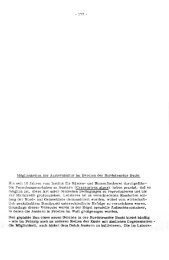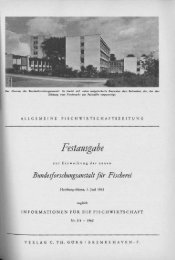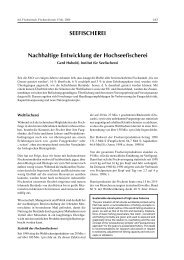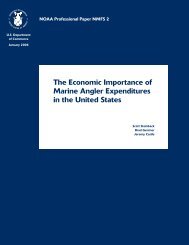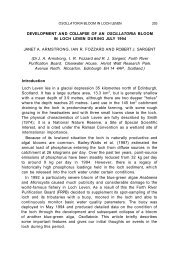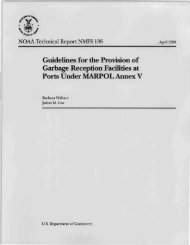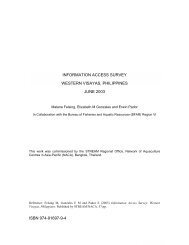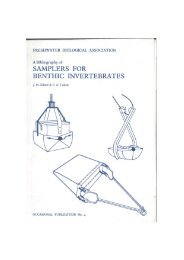Download (36Mb) - Aquatic Commons
Download (36Mb) - Aquatic Commons
Download (36Mb) - Aquatic Commons
You also want an ePaper? Increase the reach of your titles
YUMPU automatically turns print PDFs into web optimized ePapers that Google loves.
August 15, 1914<br />
THE REPUBLIC OF PANAMA<br />
August 15, 1939<br />
Bottle Alley in Colon in September 1906 before it was paved.<br />
Only a few of the streets in Panama City and Colon were<br />
E paved when the Republic was formed in 1903.<br />
The Isthmus of Panama and its history have<br />
been intimately bound up with that of the Panama<br />
Canal idea. It was along the present Canal<br />
route that the first survey was made four centuries<br />
ago. Through its territory numerous surveys<br />
have been made. The Panama route was<br />
always considered one of the most logical routes<br />
for a canal. It was at Panama, therefore, that<br />
the first actual attempt to join the two oceans<br />
was inaugurated in 1880 by Count Ferdinand<br />
de Lesseps, and it was apparent that the succesful<br />
completion of such a great undertaking would<br />
be of great benefit to the world and of special<br />
value to the Isthmus.<br />
After the formation of the new nation in 1903<br />
and the beginning of the construction of the<br />
Panama Canal by the United States Government,<br />
the two nations joined hands in the great<br />
endeavor and the relationships which have<br />
existed since that time, both political and social,<br />
have been friendly and cordial, to the benefit of<br />
both nations and to the world. The economic<br />
growth of the Republic of Panama since that<br />
time has been steady and consistent.<br />
The growth and expansion of Panama City,<br />
capital of the Republic, and Colon have been<br />
outstanding. Both are modern and flourishing<br />
cities with healthful residential sections. Thousands<br />
of tourists each year find enjoyment in<br />
visiting the romantic and historic sites of the<br />
two modern cities. Government and private<br />
enterprise have joined hands in a general program<br />
of municipal development and improvement<br />
with the result that the old and dilapidated<br />
buildings of less prosperQus days are<br />
rapidly being replaced by modern structures.<br />
Streets built for carts and carriages are being<br />
widened into modern boulevards, and a general<br />
program of beautificatipn of the two cities has<br />
been consistently carded forward during the<br />
past few years.<br />
The progressive spirit which has marked the<br />
advancement of Panama City and Colon is<br />
indicative of the advances made in the rest of<br />
the nation, and the development which has taken<br />
place within these two cosmopolitan centers forecasts<br />
similar development in other sections of the<br />
nation when the present program of highway<br />
building, opening up the interior, is completed.<br />
The economic web of these two important<br />
centers of the Republic, upon which to a large<br />
measure is based the welfare of the entire nation.<br />
is composed of many strands. No longer is<br />
Panama a rich city merely because a steady<br />
stream of gold pours through from Peru, as was<br />
the case more than three centuries ago. Its<br />
prosperity and that of Colon on the Atlantic<br />
coast is based upon many and more substantial<br />
factors. Foremost among these is the business<br />
acumen of its merchants and civic leaders who<br />
had the foresight to keep abreast of the rapidly<br />
moving times of the twentieth century; of a<br />
rapidly increasing population of their cities; and<br />
of rapidly expanding business fields.<br />
Bottle Alley in Colon in J1tIte 1907 after it was paved and<br />
sewers were installed. Great strides have bew made in<br />
municipal improvements in Panama and Colon.<br />
Located as they are adjacent to the terminal<br />
ports of the Panama Canal where thousands of<br />
ships pass every year, both Colon and Panama<br />
City are cosmopolitan centers.<br />
More than 100,000 tourists visit the Isthmus<br />
of Panama annually and provide much business<br />
for the cities of Panama and Colon. In<br />
turn, the tourists are well rewarded because the<br />
Isthmus of Panama is one of the richest in historical<br />
lore and interest of any land in the New<br />
World. Also, tourists are said to be able to make<br />
their purchases here at prices far below what<br />
they would pay elsewhere. In addition to the<br />
thousands of tourists who flock to these trade<br />
wind-swept shores every year, the United States<br />
Fleet makes periodic visits to Canal waters<br />
which stimulate trade for many months as the<br />
Page one hundred and five




